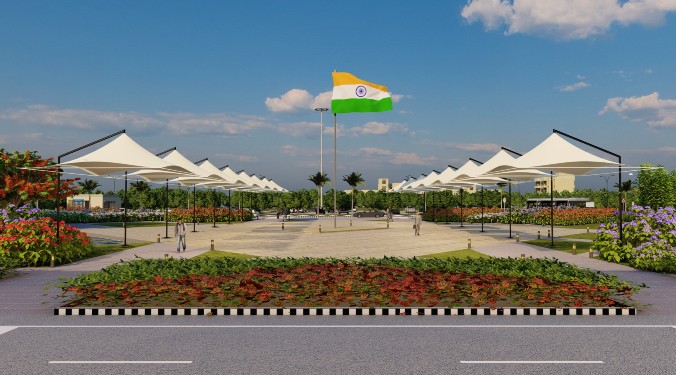“Rural roads are a means to achieve the broad objective of rural poverty reduction by providing rural population easy access to social and economic services,” said Rakesh Kumar, Assistant Director, NRRDA
National Rural Roads Development Agency(NRRDA), an agency under the Ministry of Rural Development and also the implementing agency for the Pradhana Mantri Gram Sadak Yojana (PMGSY),is transforming the rural economics by providing good all-weather road connectivity to unconnected villages. In an interview with ACE Update, Rakesh Kumar briefs us on the rural road development progress. He also sheds light on the utilisation of financial support received by PMGSY by drawing the future rural road map. Excerpts:
The government has planned to invest Rs 3 lakh crore this financial year and Rs 5 lakh crore in the five years. Do you think that the set target will be successfully implemented?Let me start with the financial year 2013-14. In this year the budget allocation for PMGSY was Rs 12,856 crore and 100 per cent of this was utilised. Against a target of connecting 3,500 habitations with all weather roads in 2013-14, a total of 6,500 habitations were connected by constructing 25,616.39 kms of PMGSY roads. The budgetary allocations for PMGSY in the financial year 2014-15 was Rs 14,200 crore which was again 100 per cent utilised. Against a target of 4,688 habitations to be connected, a total of 10,990 habitations were connected by constructing 36,883 kms of PMGSY roads. On an average, 101 kms of PMGSY roads were constructed everyday in 2014-15.In the year 2015-16, the budgetary allocation for PMGSY is Rs 14,391 crore, against which, in the first three months of the financial year about Rs 4,500 crore have been utilised.
Could you brief us on the new policies that have been introduced for rural road development?In the present financial year as well as in future, plantation on the flanks of PMGSY roads and use of non-conventional materials and new construction technologies would receive focused attention under PMGSY.
With a view to increase green cover and protect PMGSY roads, larg-scale plantation of appropriate tree species on the flanks of PMGSY roads would be taken up in convergence with MGNREGA. This has been started in the last fiscal, when about 56 lakh such trees were planted on the flanks of PMGSY roads. A detailed guideline for governing technical parameters of such plantations has been issued by NRRDA in collaboration with Indian Road Congress (IRC). This initiative would be further strengthened in 2015-16.
Also, the ministry and NRRDA are encouraging non-conventional construction materials and R&D in PMGSY roads to encourage green and environment friendly technologies in construction of rural roads, to reduce the average per kilometre cost of construction, and to increase the working season for construction of rural roads.
Some major technologies being encouraged are – cold mix technology, which replaces hot bitumen mixture in PMGSY roads. Use of cold mix technology reduces environmental pollution, cold mix roads can be thrown open to traffic within a short period of time and such roads could be constructed even in winter and rainy season. Another technology being promoted is jute and coir geotextiles. These are used in areas with bad soil where earlier good soil was to be transported at great cost from long distances. Now, with the use of jute and coir geotextiles, the requirement to transport good quality earth from long distances has been done away with. Use of flyash (a byproduct of thermal power plants), waste plastic and iron-ore is also being encouraged for construction of rural roads.
What about financial support given by Asian Development Bank (ADB)? How PMGSY is going to utilise such support?The first and foremost thing that I would like to mention is, PMGSY program has also received financial assistance from World Bank and Asian Development Bank. World Bank has allocated an amount of $ 1,400 million under Rural Road Project (RRP)-II for PMGSY. This loan is for a project period of March 2011 to November 2015 involving 24,000 kms of rural roads in 8 participating states namely Rajasthan, Uttar Pradesh, Jharkhand, Uttarakhand, Himachal Pradesh, Meghalaya, Punjab and Bihar.
Another significant contribution for the rural road development is from Asian Development Bank. Multi-Tranche Financial Facility (MFF) for $ 800 million has been signed in May 2012 by ADB with Department of Economic Affairs, Ministry of Finance and Ministry of Rural Development in order to give financial support PMGSY. MFF involves construction of 9,000 kms of rural roads in 5 states of Assam, Chhattisgarh, Madhya Pradesh, Odhisa and West Bengal. Both these projects have been characterised by the lending agencies as successful.
What are the major obstacles NRRDA faces when it comes to rural road development? And what are the ways to overcome them? In the 14 years of implementation of PMGSY, about 1,10,000 habitations across the country have been connected and about 4,50,000 kms of all weather rural roads have been constructed. There are some limitations in the implementation of this programme such as limited execution and absorption capacity of some states, particularly, in North-East and Himalayan states. Limited contracting capacity in left wing violence affected districts of the country. North-Eastern states as well as states like J&K, Himachal Pradesh and Uttarakhand has limited working season.
To address these limitations, constant support and collaboration with state government is ensured. Number of Project Implementation Units (PIUs) and field engineers have been increased in the states. Also, NRRDA organises training for field engineers, contractors and contractor’s engineers on a regular basis. In left wing violence affected areas, the standard bidding document for PMGSY roads has been rationalised and simplified and special dispensation or relaxation have been granted for award of PMGSY works.
What are the social, environmental guidelines that are supposed to be followed for rural road development?When it comes to social, environmental guidelines, NRRDA has issued Environmental Codes of Practice including Environmental Management Framework for all the states. The main thrust of PMGSY in the road sector remains to build a sustainable and environment friendly road infrastructure for low volume rural roads. To achieve this objective, regular training of field engineers and local community on Environmental Codes of Practice is organised by NRRDA.
What is your rural road development vision?The long-term plan for rural road development would focus on ensuring that all eligible 1,78,184 habitations across the country are connected by all weather roads. We have to ensure that consolidation and strengthening of rural road network under PMGSY-II is achieved by upgradation of 50,000 kms of rural roads across the country.
We have to also ensure that all states operationalise “Rural Road Maintenance Policies” and “Asset Management Systems” which would facilitate regular maintenance and upkeep of rural road assets.
Rural roads are a means to achieve the broad objective of rural poverty reduction by providing rural population easy access to social and economic services. Therefore, the long-term vision would facilitate rural road construction and maintenance along with development and operationalisation of rural transportation services.
Cookie Consent
We use cookies to personalize your experience. By continuing to visit this website you agree to our Terms & Conditions, Privacy Policy and Cookie Policy.









